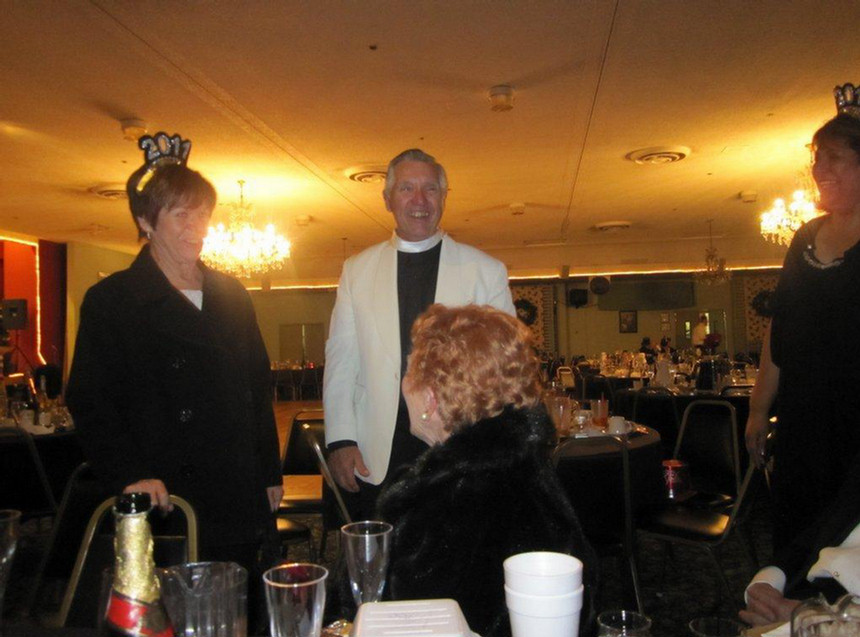New Years 2011 Celebration At The Elks
The magic in new beginnings is truly the most powerful of them all.
New Years Eve At The Santa Ana Elks (Page Three)
The evening progressed and the cavorting was into full swing! We were dancing and wine tasting Tasting the forbidden grape... Maybe guzzling???

Ruby stayed home and had her own party...

Donna does some artistic arrangements


The party is over... For some of the Elks.... Ours is just beginning



And it was this big... The one that got away


Wise words from AJ.... But, how does he know?
Meanwhile Over In The Corner...

He actually got that fly that was on the ceiling
Did You Know? - A party horn, also known as a blow-out, noisemaker or a squeaker, is a horn formed from a paper tube, often one that is flattened and rolled into a coil, and which unrolls when blown into, producing a horn-like noise. Modern variations have a plastic mouthpiece, which prevents the swift degradation of the device from exposure to the moisture of the mouth.

I know he is going to explode

Watch carefully....

"OMG... This IS happening to me!"

The "Kids" Stayed One Table Away... Wonder Why??


Meanwhile Back In The Corner

Greg found another use for the party horn

Ear cleaning from 18 inches away
Remember This One? - We will open the book. Its pages are blank. We are going to put words on them ourselves. The book is called Opportunity and its first chapter is New Year's Day. ~Edith Lovejoy Pierce


Midnight Has Arrived
Did You Know? - In traditional magical thinking, "midnight" refers to solar midnight, which is opposite solar noon. These form an axis linking the mundane world with otherworlds by being the apogee of darkness and the perigee of light. Thus, traditional midnight is associated with chaos, death, the underworld and mystery. It was seen as a moment when sacrum manifests itself and epiphanies were most likely. The epiphanies expected were those associated with darkness, so it was thought that at midnight, visitation from spirits, ghosts, demons and devils were common
All the supernatural creatures of darkness — reminiscent of feared nocturnal predators — were believed to haunt the night, their potency greatest at its central point, midnight. According to Slavic folklore, midnight was time when strigas rose from graves to suck the blood of mortals, dance the Samba, zmoras assailed the sleeping to steal their breath, and devils came for sinners. Polish Jews believed that it was the time when dybbuks possessed people, causing insanity.
Good definition of our group

First toast of the evening

Bob tried many toasts to attempt to get it correct



"Watch your hands you little devil!"

"I got the picture...."



"No ossifer... This is not alcohol... It's cham-pagg-knee!"

"Happy New Year"

Vince it so stober....


We caught them!


Oh oh... She caught him... We caught each other

Greg Gives Booging Lessons In The Corner
Did You Know? - Boogie is a repetitive, swung note or shuffle rhythm, "groove" or pattern used in blues which was originally played on the piano in boogie-woogie music. The characteristic rhythm and feel of the boogie was then adapted to guitar, double bass, and other instruments.
The earliest recorded boogie-woogie song was in 1916. By the 1930s, Swing bands such as Glenn Miller, Tommy Dorsey, and Louis Jordan all had boogie hits. By the 1950s, boogie became incorporated into the emerging rockabilly and rock and roll styles. In the late 1980s and the early 1990s country bands released country boogies.
Today, the term "boogie" usually refers to dancing to pop, disco, or rock music, or it means "hurry" (as in "let's boogie on out of here").

"I do not charge much to teach a few steps"

"Ya claps to the left and then you claps to the right"

The Dancing Continues



Checking up on everyone
The Three Cabba-Yellows

The Three Caballeros is a 1944 Disney animated feature film, produced by Walt Disney and distributed by RKO Radio Pictures. The film premiered in Mexico City on December 21, 1944 (five days after Paul was born!!!).
It was released in the United States on February 3, 1945. The seventh animated feature in the Walt Disney Animated Classics series, the film plots an adventure through parts of Latin America, combining live-action and animation. This is the second of the Disney package films of the 1940s.
The film is plotted as a series of self-contained segments, strung together by the device of Donald Duck opening birthday gifts from his Latin American friends.
Several Latin American stars of the period appear, including singers Aurora Miranda (sister of Carmen Miranda) and Dora Luz, as well as dancer Carmen Molina.
The film was produced as part of the studio's good will message for South America, but is less obviously propagandistic than others.
The film again starred Donald Duck, who in the course of the film is joined by old friend José Carioca, the cigar-smoking parrot from Saludos Amigos (1942) representing Brazil, and later makes a new friend in the persona of pistol-packing rooster Panchito Pistoles, representing Mexico.

Time for a line up.... Del and Greg arenot worried IF they are looking for a fat guy!
Girls Go First

Yo! The rest of you...


All the girls are here now.... Even Vince!

A bevy of beauties (except for Vance)




Now The Boys

"OK Bob, what do we do with Leon???"

Perfect
Sing.... "39 Bottles Of Wine On The Wall, 39 Bottles Of Wine"


The Parry Is Over... We Again Close The Place Down!




Not a single stain! It's magic!

Notice... All the other tables are empty


Two folks were lost... We assisted them out
Father Roberts Is Going To Speak To Us


Good Night All And Happy New Year 2011
